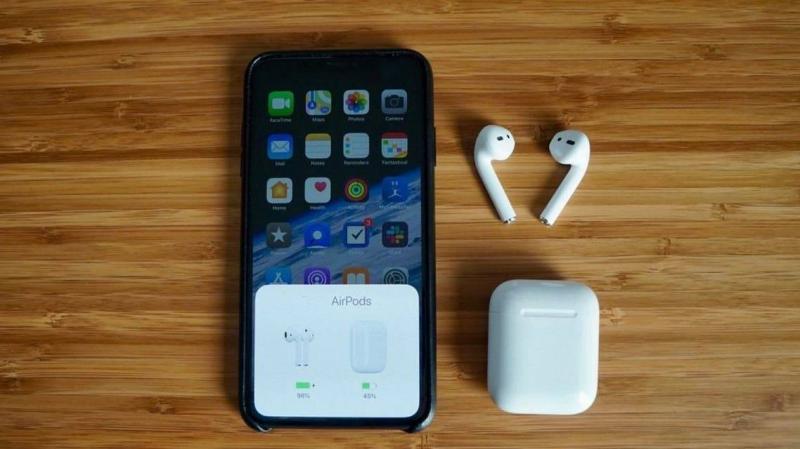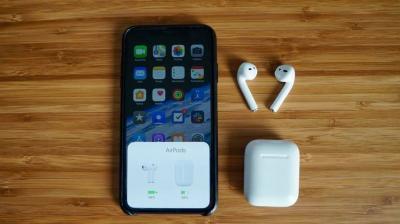Apple has announced the third generation of its wireless earphones, AirPods, the latest addition to its highly popular true wireless earbuds, featuring spatial audio. The company also launched a MacBook Pro in 14-inch and 16-inch sizes. Priced at $179, the third generation of AirPods is available for pre-order today and will go on sale next week, on October 26.
With a new design that combines elements from previous AirPods and AirPods Pro, the third generation AirPods retain a sturdy plastic build with a one-size-fits-most approach. However, the shape has undergone a significant change for the first time since 2016, now featuring much shorter stems than before. The earbuds are also now water and sweat resistant with an IPX4 rating for both the earbuds and the charging case.
Battery life has been extended to six hours of continuous listening and up to four hours of talk time. Just five minutes of charging provides about an hour of battery life. With the case, users can enjoy a total of 30 hours of listening time. They feature a force sensor for easy control of music playback and calls. AirPods are now also part of Apple's MagSafe wireless charging ecosystem.
The new third generation AirPods include a redesigned custom driver and an Adaptive EQ that automatically adjusts and optimizes sound output by combining the power of the H1 chip with the company’s custom acoustic system. An inward-facing microphone helps optimize the sound, and then Adaptive EQ, powered by computational audio, modifies the low and mid frequencies to account for any loss due to fit variations. The company placed a strong emphasis on spatial audio, integrating Dolby Atmos music with the new AirPods and supporting the same dynamic head tracking capabilities as AirPods Pro and AirPods Max.
The original AirPods were released in 2016 and were followed by the second generation, which added wireless charging and modest improvements. AirPods Pro arrived in 2019 with a traditional in-ear fit and silicone ear tips. Last year, Apple expanded its AirPods line to include over-ear headphones for the first time with the launch of AirPods Max, priced at $549. There has been considerable pressure on the latest AirPods to maintain the huge popularity of previous generations. These earbuds are favored for their ease of use and seamless integration with the company's ecosystem of devices, including iPhone, iPad, Mac, Apple Watch, and Apple TV. However, Apple faces strong competition, particularly at lower price points, from alternatives by Samsung, Sony, Amazon, Jabra, and newcomers like Nothing, which aim to stand out with design and value starting at around $99.
Greg Joswiak, Apple's Senior Vice President of Worldwide Marketing, stated: "AirPods changed wireless headphones with their innovative design, amazing sound, and magical experience. We are excited to introduce the next generation of AirPods, featuring unmatched sound through Adaptive EQ and spatial audio with dynamic head tracking, alongside seamless interaction across Apple devices, making the world’s best-selling earbuds even better."
The third generation AirPods rely on the sound quality that AirPods are known for, starting from the custom driver and high-dynamic-range amplifier that together produce powerful, high-frequency sound. The microphone is covered with a mesh to help reduce wind noise, ensuring the sound is clear during calls. The AirPods also feature AAC-ELD, a high-definition speech codec that provides ultra-clear, natural-sounding FaceTime calls. Advanced spatial audio algorithms, using directional audio filters to adjust the frequencies received by each ear, allow the new AirPods to place sounds around the user. Audio sharing enables users to stream audio between two sets of AirPods or AirPods Pro or AirPods Max while using an iPhone, iPad, iPod touch, or Apple TV. A new skin-detection sensor accurately determines whether the AirPods are in the ear and pauses playback when removed. To enhance voice clarity, radial beamforming microphones block out surrounding noise and focus on the user's voice, while users can also enjoy a hands-free experience by just saying "Hey Siri" for requests.
### Apple Launches 16-inch MacBook Pro
Apple also announced a new 16-inch MacBook Pro, promising updates to both design and performance. The new models will be available in silver and space gray next week, starting at $2,499. The new 16-inch MacBook Pro is configurable with the new M1 Pro and M1 Max chips, featuring ten-core processors with 8 high-performance cores and 2 high-efficiency cores. The M1 Max has double the GPU cores of the M1 Pro (32 for M1 Max versus 16 for M1 Pro) and doubles the memory bandwidth, along with 64GB of unified memory (M1 Pro has 32GB).
The chassis has also been notably redesigned. The device weighs 2.1 kg with a thickness of 16.8mm and has a 16.2-inch display. The Touch Bar has been replaced with physical keys, there is an HDMI port on the right side, as well as a Thunderbolt 4 port and an SD card slot, along with a headphone jack and two Thunderbolt 4 ports on the left.
### 14-inch MacBook Pro
The company has also redesigned the 14-inch MacBook Pro, which now features the new company's M1 Pro and M1 Max chips, a notch, and a wide range of ports in addition to standard Thunderbolt ports. Starting at $1,999, it can be ordered on Monday. This laptop returns the HDMI port and SD card reader, adding a MagSafe 3 connector for charging (though it can also be charged via Thunderbolt ports). The device has a 14.2-inch ProMotion MiniLED display with a 120Hz refresh rate, branded as Liquid Retina Pro XDR. The device features thinner bezels compared to the previous generation and includes a notch containing a 1080p webcam but lacks FaceID.
In terms of resolution, the 14-inch model operates at 3024x1964 pixels. It can sustain 1000 nits of brightness and peak at 1600 nits. The new 14-inch MacBook Pro can be configured with the new M1 Pro or M1 Max chips, both featuring 10 CPU cores. The M1 Pro can have either 14 or 16 GPU cores, while the M1 Max can come with 24 or 32 GPU cores. The new MacBook Pro comes with 16GB of RAM, upgradeable to 32GB with M1 Pro or 64GB with M1 Max.
In addition to all the new ports, the MacBook Pro adds a third Thunderbolt port compared to its 13-inch counterpart. The Thunderbolt ports are now Thunderbolt 4, an upgrade from the Thunderbolt 3 ports in previous models.
### New Operating System
During the Unleashed event, Apple revealed that the next version of its operating system for computers, called macOS Monterey, will begin rolling out as an update on Monday, October 25. The new operating system includes many improvements for FaceTime, including support for spatial audio. It also offers other exciting features such as the ability to use SharePlay to listen to music and watch videos with friends. Universal Control represents one of the biggest changes, allowing users to seamlessly navigate between a Mac and iPad and transfer files smoothly between multiple devices and type on an iPad from a MacBook's keyboard.




